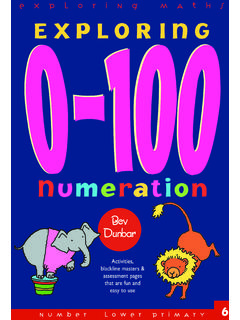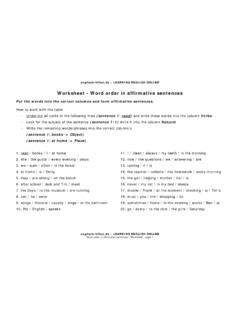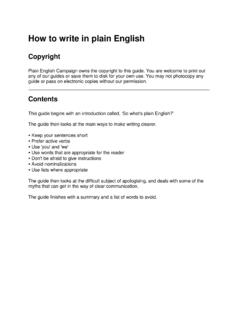Transcription of NAPLAN* Persuasive Text sample work sheets – Secondary ...
1 NAPLAN* Persuasive Text sample work sheets Secondary ISBN 978-1-921680-50-2 Copying for educational purposes Copyright information Teachers can download and supply this material to their students according to the following copyright conditions: The purchasing educational institution may only download, print and photocopy pages of this work sheet resource in accordance with The Australian Copyright Act 1968 (the Act) and provided the educational institution (or body that administers it) has given a remuneration notice to the Copyright Agency Limited (CAL) under the Act. It is mandatory, that the ALL photocopies are recorded by the institution for CAL survey purposes.
2 For details of the CAL license for educational institutions contact:Copyright Agency Limited Level 15, 233 Castlereagh Street Sydney, NSW, 2000 Telephone: (02)9394 7600 Purchasers do not have the right to resell, distribute, or pass off as their own, any material contained in this resource. All photocopies or downloads must bear the Blake Education copyright line. Users may not remove or obscure the publisher copyright and trademark notices from this resource. * This is not an officially endorsed publication of the NAPLAN program and is produces by Blake Education independently of Australian Governments. Dear Teacher, I hope you enjoy using these downloadable pages and that they assist your students to prepare for the annual national literacy texts.
3 With changes to the 2011 tests confirmed, these pages focus on analysing and writing Persuasive Texts. This download includes: Pages 1 & 2 An explanation of the purpose, structure and language features of Persuasive Texts that can be photocopied and distributed for individual student use. Or the content could be copied on to A3-size paper to make posters for each English classroom. Pages 3 & 4 An advertisement for a new chocolate bar with key Persuasive writing techniques highlighted and explained. Students are asked to take note of how the writer has used the techniques. This is followed by an advertisement for airship travel where students are asked to link each provided Persuasive technique with its example in the 5, 6 & 7 An essay about organic farming with key Persuasive writing techniques highlighted and explained.
4 This is followed by an essay about asylum seekers with key Persuasive writing techniques highlighted and explained. Students are asked to make note of how the writer has used the 8 & 9 A speech about cyber-bullying is annotated with key Persuasive writing techniques. Students are asked to make note of how the writer has used the 10 & 11 Two new Persuasive writing tasks for students. The first is an essay task about the relevance of the Commonwealth Games to modern society. The second topic is a speech task about whether fast food restaurants should be closed 12-14 Detailed assessment rubrics to assist you when marking the two writing tasks on page 10 and 11.
5 Wishing you and your students success with the national tests in May! Kind regards,Jennifer Gough Secondary Teacher Resource Publisher Blake Education Persuasive texts work sheets ( Secondary ) ISBN 978-1-921680-50-2 Blake Education, 2010 Persuasive TEXTS The PurPoSe of Persuasive TexTS Writers compose Persuasive texts to influence readers to accept an opinion, buy a product, adopt an idea, take a particular action or believe their interpretation of specific facts. Some Persuasive texts aim to influence readers to believe one point of view over another, while others may present only a single point of texts that present a single viewpoint or opinion may contain bias - the unfair presentation of one side of an argument as more valid than another.
6 Because the writer is attempting to convince readers to accept a certain idea or point of view, Persuasive texts require some analytical thinking by the , some people approach Persuasive texts as if they are informative, which means they may be tempted to accept the content as true when it is actually just someone s of Persuasive texts include essays, advertisements, letters to the editor, book blurbs and STrucTure of Persuasive TexTS Persuasive texts often contain an introduction, followed by a series of paragraphs presenting key points, and a conclusion. They usually contain facts and details organised in a logical manner and presented systematically. Each paragraph begins with a topic sentence, which is developed with supporting evidence, examples, facts, details and other content designed to reinforce a key a Persuasive text, ideas are supported by evidence.
7 The skilful use of evidence can help a good writer convince readers to adopt a particular point of view about a topic. The laNguage feaTureS of Persuasive TexTS The structural and language features of Persuasive texts include: introduction, main body and conclusion paragraphs introduced by a topic sentence a central line of argument that can be traced throughout the text details, facts, examples and other material that support the line of argument restatement of the main points of the argument in a conclusion quotations from authorities and other sources level of language suited to the target audience rhetorical questions exaggeration simplification or generalisation repetition contrast and comparison emotive language language that is high in modality (for example, words such as must rather than should or will rather than might).
8 TIPM odality in language refers to the way we express the truth of an idea. Modal verbs carry a judgment about the likelihood of a particular event occurring. Nine common modal verbs are: can, could, may, might, will, would, shall, should and Persuasive texts work sheets ( Secondary ) ISBN 978-1-921680-50-2 Blake Education, 2010 Persuasive TEXTS When writing a Persuasive text of your own, ask yourself these questions to ensure that your text has the language features and structure of the Persuasive form. Is the language level appropriate to the target audience? Has the main argument (thesis) been summarised? Does the text present the strongest (or most Persuasive ) idea first?
9 Does it contain a lot of evaluative adjectives (for example, very, most, always)? Have I used a range of imagery-creating techniques (such as metaphors and personification)? Has one view been presented as more accurate than all opposing views? Have I presented opposing views and then dismantled them effectively? Have I quoted other authorities to support my argument? Have I used topic sentences to begin each new paragraph? Have I included details that support each point (for example, quotes, descriptions, examples and evidence)? Has factual information been included? If necessary, has statistical data been presented? Have I referred to recent research?
10 Have I asked rhetorical questions? Is exaggeration employed to prove a particular point? Have I repeated key ideas, words and phrases for emphasis? Have I used emotive language effectively? Is my language of appraisal high in modality (for example, words such as must rather than should, or will rather than might)? Are connective words used to link ideas? Have I used contrast and comparison to highlight key ideas? Have I asked questions to reinforce main points?language features specific to advertising texts Does the text capture the attention of the reader? Will the text engage and interest the reader throughout? Does the text create a desire for the reader to accept the idea (or buy the product)?










